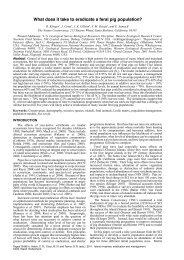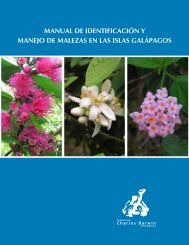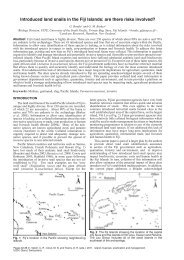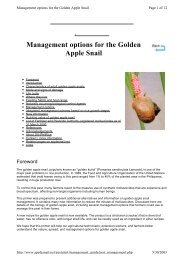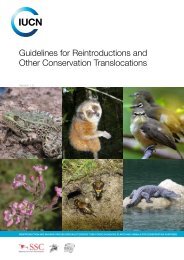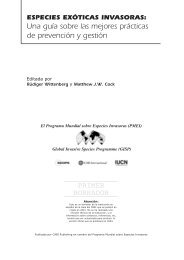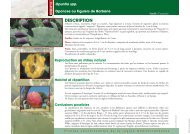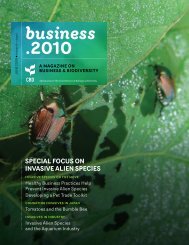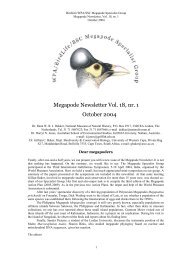Aliens Newsletter - ISSG
Aliens Newsletter - ISSG
Aliens Newsletter - ISSG
Create successful ePaper yourself
Turn your PDF publications into a flip-book with our unique Google optimized e-Paper software.
“Beaufort Scale” for bioinvasion impacts<br />
Sergej Olenin & Aleksas Narsˇčius<br />
Why a standardized bioinvasion impact assessment<br />
system?<br />
More than two hundred years ago Sir Francis Beaufort,<br />
a British admiral and hydrographer, introduced<br />
a scale of sea state to oblige his naval officers reporting<br />
weather observations in a standardized way.<br />
It seems that bioinvasion science and management<br />
needs something similar in order to reduce subjectivism<br />
in assessment and reporting the impacts<br />
caused by Invasive Alien Species (IAS). So far such<br />
assessments have been based on expert judgment.<br />
Even in the listings of worst invaders their impacts<br />
often are being reported without indication on how<br />
severe the impact is.<br />
On another side, a standardized description and<br />
evaluation of impacts is needed for many applications,<br />
e.g. for compilation of “black” lists of target<br />
IAS and comparative account of their harmful effects;<br />
prioritization of management options, which<br />
involve species that can be practically managed in<br />
some way; for compassion of the same IAS in different<br />
ecosystems; and even for overall environmental<br />
status assessments taking into account the<br />
bioinvasion effects in particular territories or water<br />
bodies.<br />
Theory: a biopollution level index<br />
The approach to estimate the magnitude of bioinvasion<br />
impacts or “Biopollution level” (BPL) index<br />
was developed by a team of researchers within two<br />
recent EU funded projects, ALARM and DAISIE<br />
(Olenin et al., 2007). Biological pollution is defined<br />
as the impact of alien species on ecological quality<br />
and includes (but is not confined to) the genetic<br />
alteration within populations, the deterioration or<br />
modification of habitats, the spreading of pathogens<br />
and parasites, competition with and replacement of<br />
native species, etc.<br />
The BPL method takes into account the abundance<br />
and distribution range (ADR) of alien species in relation<br />
to native biota and aggregates data on the<br />
magnitude of the impacts in three categories: 1) impacts<br />
on native communities, 2) habitats and, 3)<br />
ecosystem functioning. ADR varies within five<br />
classes, ranking an alien species from low abundance<br />
in a few localities (A) to occurrence in high<br />
numbers in all localities (E). After ADR is established,<br />
three categories of impacts are considered,<br />
whose magnitude is ranked on five levels ranging<br />
from no impact (0) to massive impact (4) based on<br />
qualitative changes in an invaded ecosystem. The<br />
theoretical justification uses several well established<br />
ecological concepts, e.g. “key species”, “type specific<br />
communities”, “habitat alteration, fragmentation<br />
and loss”, “functional groups”, “food web<br />
shift”, etc. BPL aggregates the results of the assessment<br />
into five categories: “No bioinvasion impact”,<br />
“Weak”, “Moderate”, “Strong” and “Massive”.<br />
The assessment should be performed in a defined<br />
assessment unit (a coastal lagoon, a lake, an island,<br />
etc) and for a defined assessment period. Primarily<br />
the method was designed for aquatic environment,<br />
but now it is being adapted for terrestrial<br />
species and ecosystems as well.<br />
Implementation<br />
The theoretical background was used to develop a<br />
system aimed at translation of existing data on miscellaneous<br />
invasive species impacts into uniform<br />
biopollution measurement units: BINPAS (Biological<br />
Invasion Impact / Biopollution Assessment System).<br />
The experimental version of BINPAS was<br />
published in early 2008. The application and database<br />
is hosted by the server of the Coastal Research<br />
and Planning Institute, Klaipeda University, Lithuania.<br />
Since then BINPAS is being developed using<br />
open source web technologies (Apache, PHP5) and<br />
MySQL relational database management system.<br />
The system is freely accessible by internet at<br />
http://corpi.ku.lt/databases/binpas/.<br />
Registration to BINPAS is open for all willing to<br />
contribute with their data. On login to BINPAS a<br />
registered user can create a new assessment unit ac-<br />
52 29/2010



